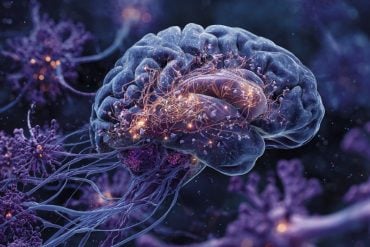Summary: A study reveals that adequate sleep can help children combat impulsive behaviors often induced by stressful environments. Researchers analyzed data from over 11,000 children aged 9-10, finding that those who had less than nine hours of sleep or took over 30 minutes to fall asleep exhibited more impulsive behaviors.
Sleep served as a mediator; when sleep problems were absent, impulsivity was less likely. The findings may offer a cost-efficient way to help children in stressful situations through sleep interventions.
Key Facts:
- The study found a strong link between lack of sleep (less than 9 hours) or long sleep latency (more than 30 minutes) and impulsive behaviors in children.
- Neurological hyperconnectivity in the default mode network of the brain also played a role in exacerbating the link between stressful environments, sleep, and impulsivity.
- The study suggests that addressing sleep as a modifiable behavior could be a cost-efficient way to help children, particularly those in stressful environments.
Source: University of Georgia
Sleep is a critical part of a child’s overall health, but it can also be an important factor in the way they behave.
According to a new study from the Youth Development Institute at University of Georgia, getting enough sleep can help children combat the effects of stressful environments.
“Stressful environments are shown to make adolescents seek immediate rewards rather than delayed rewards, but there are also adolescents who are in stressful environments who are not impulsive,” said lead author Linhao Zhang, a fourth-year doctoral student in UGA’s College of Family and Consumer Sciences.

“We looked at what explains that link and what makes some people differ from others. One mechanism we found is sleep.”
Researchers analyzed data from the Adolescent Brain Cognitive Development Study, a multi-year brain development study funded by the National Institutes of Health. Using information from 11,858 children from 9-10 years old, they found that lack of sleep and long sleep latency—the amount of time it takes to get to sleep—had a significant link to impulsive behaviors down the line.
Sleep problems, such as sleep latency (the time it takes an individual to fall asleep) and impulsive behaviors, were checked at multiple time points over the course of two years.
When children got less than the recommended nine hours of sleep or took more than 30 minutes to get to sleep, there was a strong link to impulsive behaviors later down the line.
Some of these behaviors included acting without a plan, seeking thrills or sensations, and lacking perseverance.
Sleep was a mediator between these actions, however, and when sleep problems were absent during the study, impulsivity was also less likely to be observed in the future.
Neurological hyperconnectivity, wherein the adolescents’ brains remained very active even when they were not actively engaged in tasks, also played a role, Zhang said.
This study looked at the default mode network, a brain network related to goal-directed behaviors. When this network was hyperactive during resting-state, it could exacerbate the link between stressful environments, sleep and impulsivity.
This connection could be linked to ADHD, which Zhang would like to explore in future studies.
“We can look at the default mode network and emotional regulation regions,” Zhang said. “It’s also possible that this hyperactivity and ADHD are highly correlated, so in a future study, we could test that in a more clinical setting. That could have great implications on intervention or counseling programs.”
These findings not only highlight sleep’s role in cognitive and behavioral development, but could also inform low-cost interventions to aid in the psychological development of children facing at-home stressors, Zhang said.
“If you want to develop interventions for people in stressful environments, it’s very costly, and sometimes it needs generational work to change,” Zhang said. “Sleep is a modifiable behavior, however, and these changes can be cost-efficient.”
Zhang said that too little sleep can be an issue even outside stressful environments. For example, teenagers often have a circadian rhythm that is geared toward staying up later and sleeping in, but early school start times and late nights completing homework can throw off that rhythm.
“A lot of adolescents don’t have enough time to sleep, and they are sleep deprived,” Zhang said. “This study shows why it is important to promote longer sleep duration by delaying school start times or establishing routines so that adolescents know, ‘OK, after this event, I’m going to bed.’”
Establishing these routines, no matter the environment, can create healthier patterns and reduce the time it takes to get to sleep. It’s also vital to act early when developing sleep habits, Zhang said.
“For people who may be in disadvantaged environments, if we can provide some strategies that help sleep, it can have a positive impact, especially for adolescents that are at such a critical developmental stage for their brain development.”
About this sleep and impulsivity research news
Author: Cole Sosebee
Source: University of Georgia
Contact: Cole Sosebee – University of Georgia
Image: The image is credited to Neuroscience News
Original Research: Open access.
“Sleep mediates the effect of stressful environments on youth development of impulsivity: The moderating role of within default mode network resting-state functional connectivity” by Linhao Zhang et al. Sleep Health
Abstract
Sleep mediates the effect of stressful environments on youth development of impulsivity: The moderating role of within default mode network resting-state functional connectivity
Objectives
Youth raised in stressful environments are at increased risk for developing impulsive traits, which are a robust precursor of problem behaviors. Sleep may mediate the link between stress and problem behaviors as it is both sensitive to stress and essential for neurocognitive development underlying behavioral control during adolescence. The default mode network (DMN) is a brain network implicated in stress regulation and sleep. Yet, it is poorly understood how individual differences in resting-state DMN moderate the effect of stressful environments on impulsivity via sleep problems.
Methods
Three waves of data spanning 2 years were obtained from the Adolescent Brain and Cognitive Development Study, a national longitudinal sample of 11,878 children (Mage at baseline = 10.1; 47.8% female). Structural equation modeling was used to test (a) the mediating role of sleep at T3 in the link between stressful environments at baseline and impulsivity at T5 and (b) the moderation of this indirect association by baseline levels of within-DMN resting-state functional connectivity.
Results
Sleep problems, shorter sleep duration, and longer sleep latency significantly mediated the link between stressful environments and youth impulsivity. Youth with elevated within-DMN resting-state functional connectivity showed intensified associations between stressful environments and impulsivity via shorter sleep duration.
Conclusion
Our findings suggest that sleep health can be a target for preventive intervention and thereby mitigate the link between stressful environments and increased levels of youth impulsivity.






